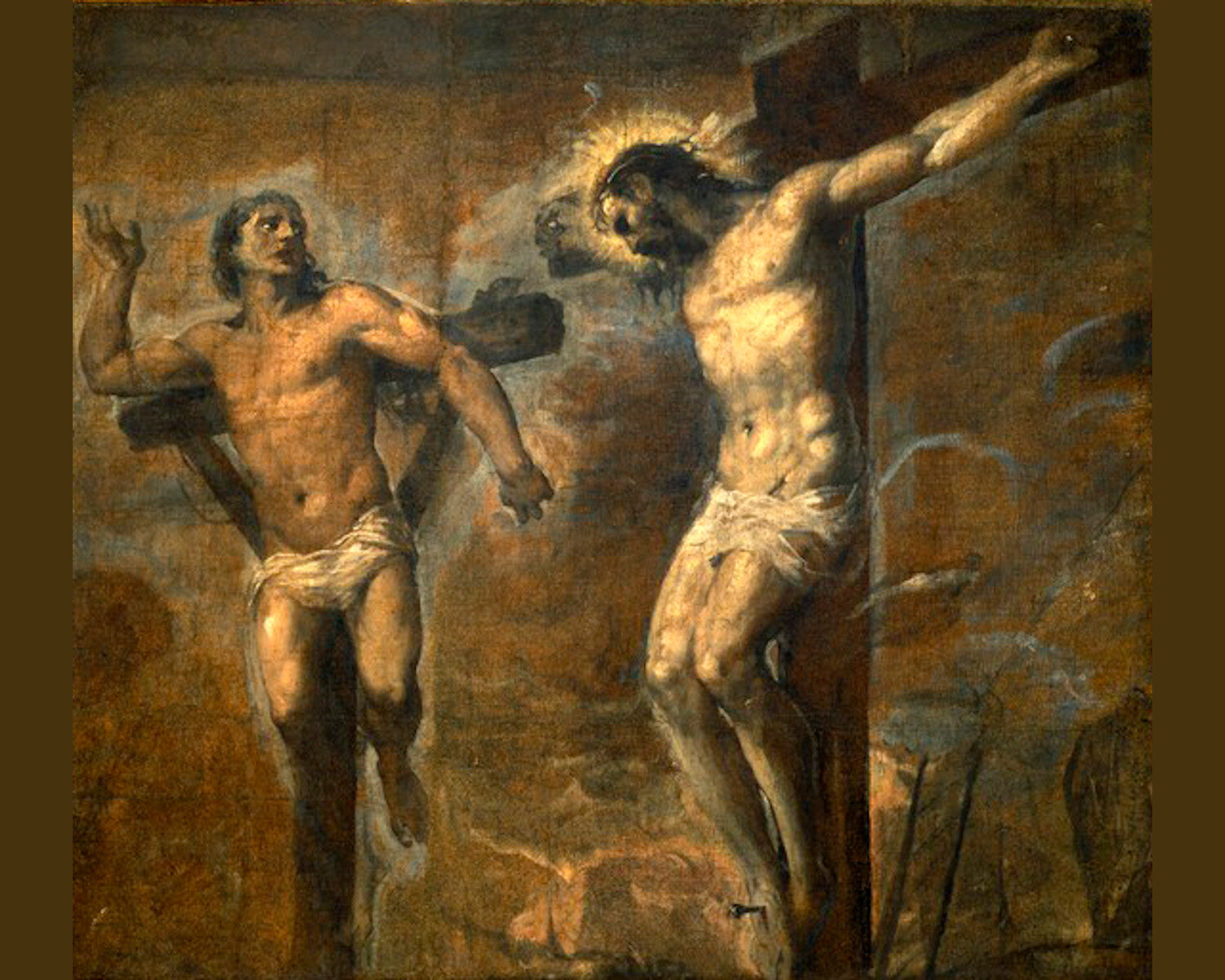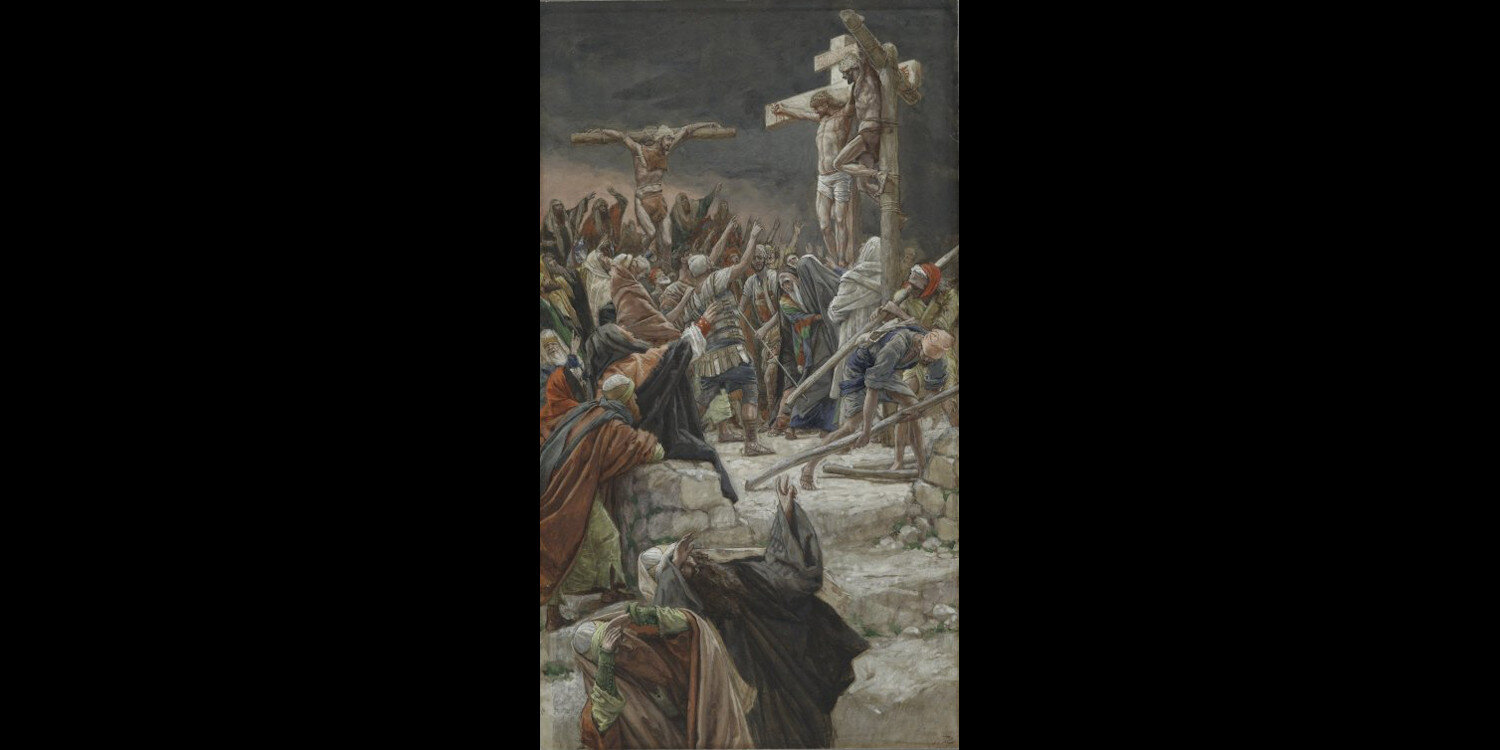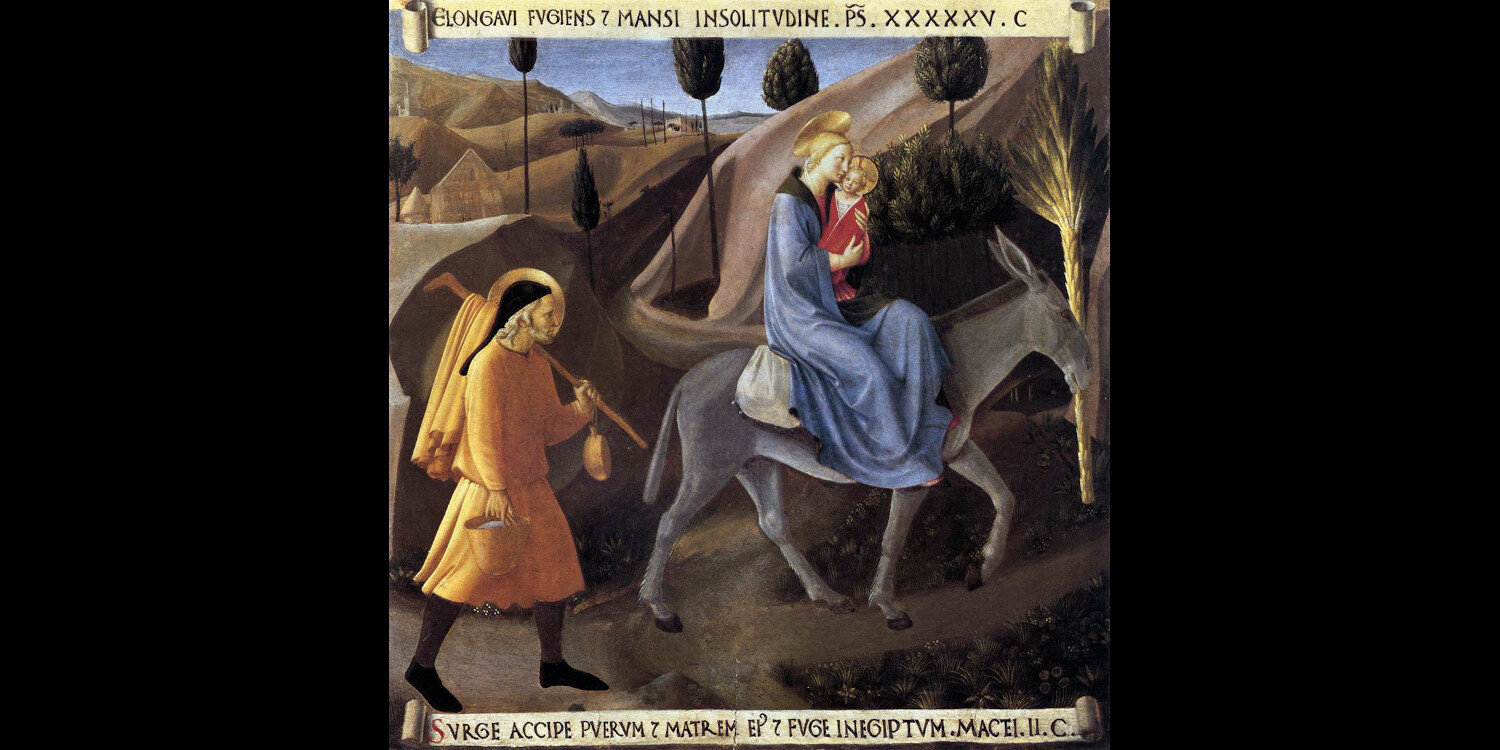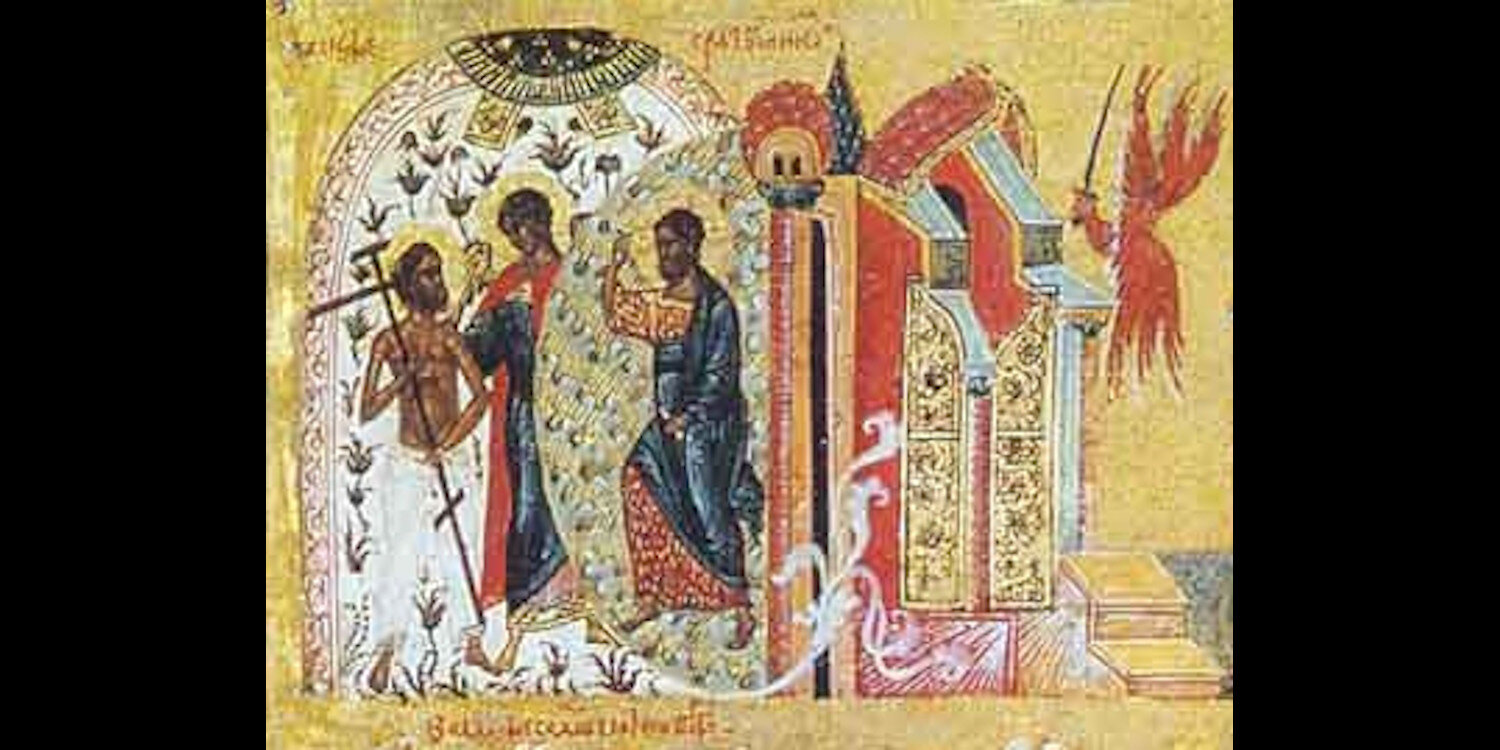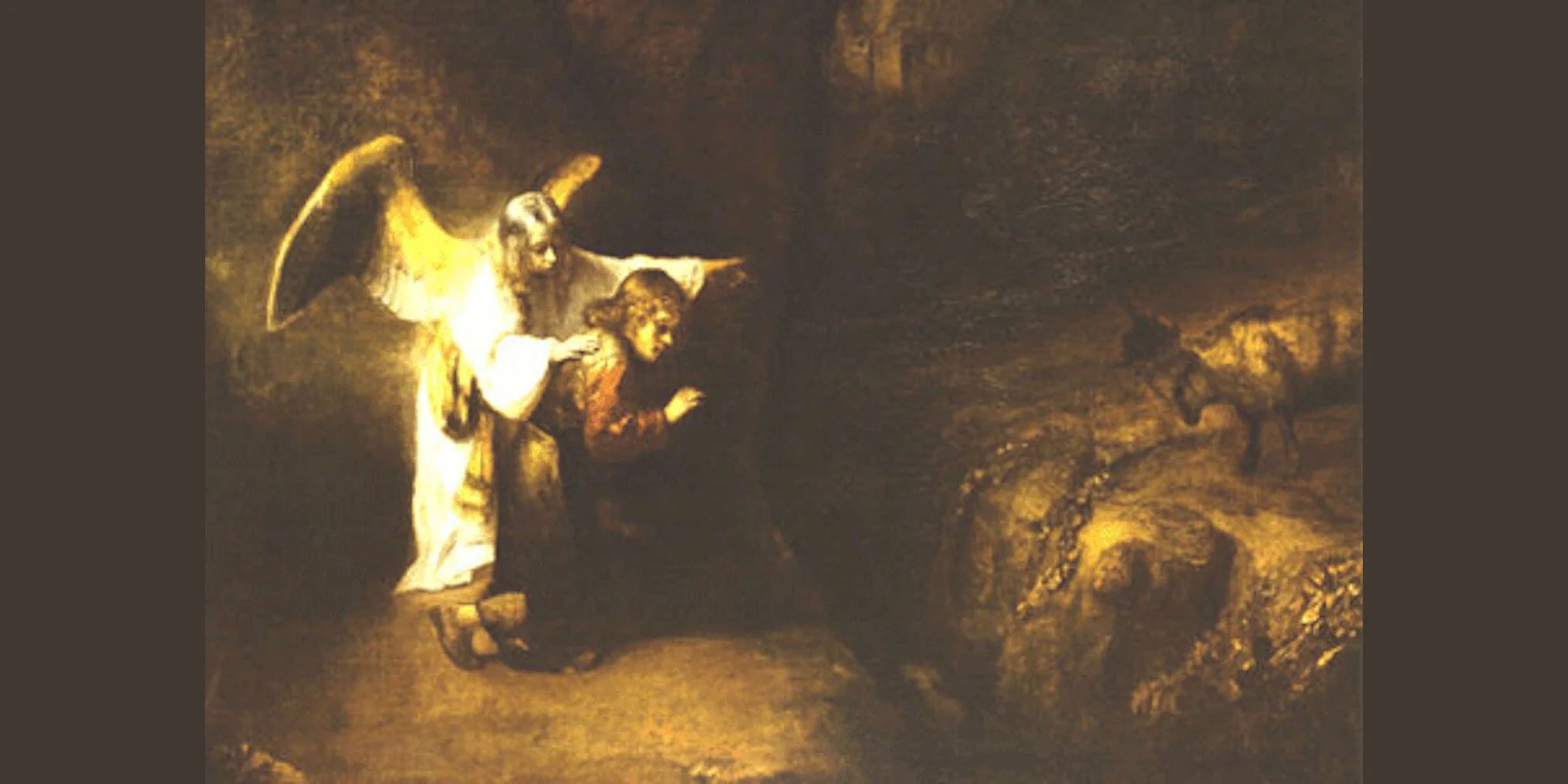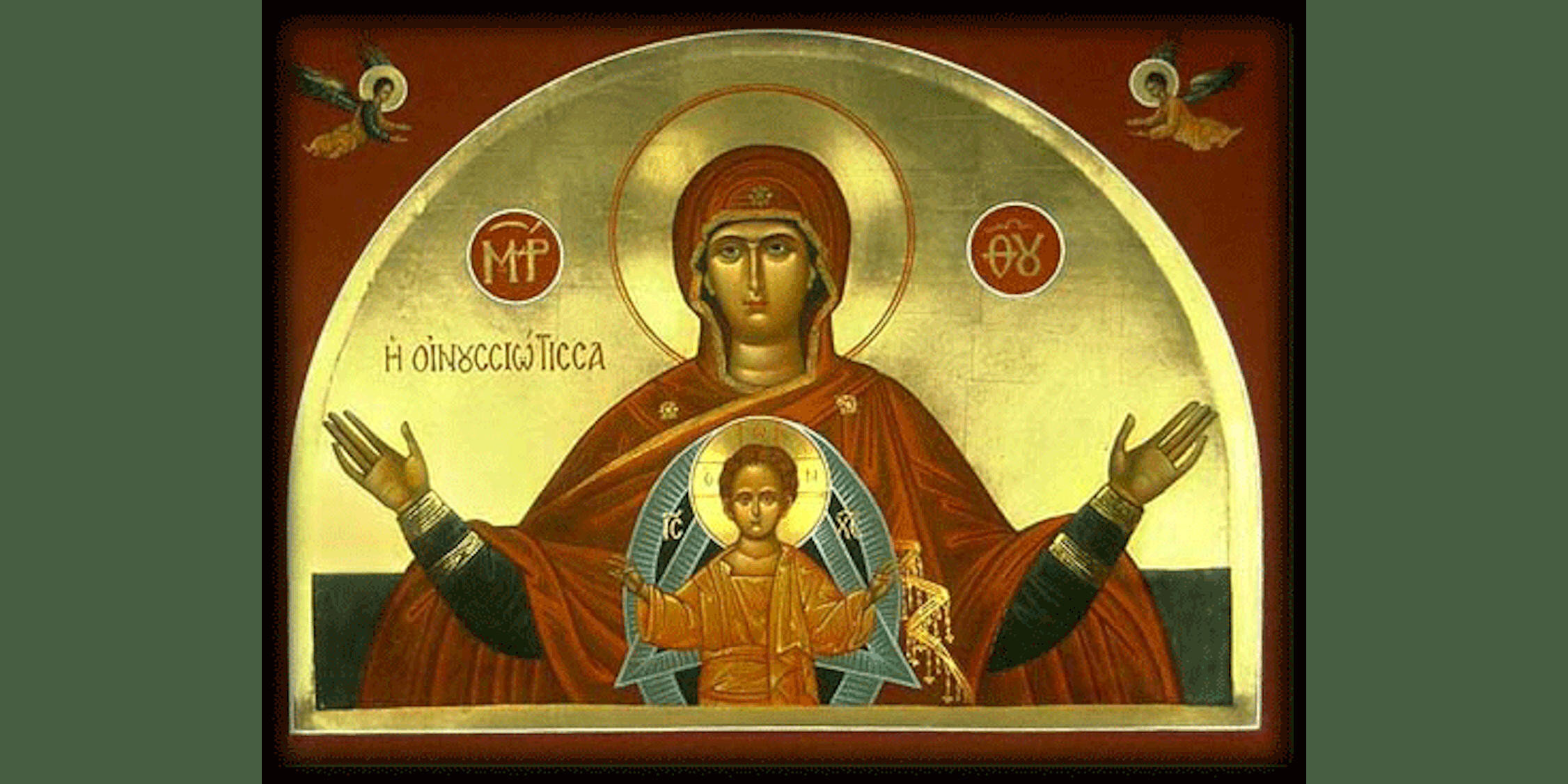“There are few authentic prophetic voices among us, guiding truth-seekers along the right path. Among them is Fr. Gordon MacRae, a mighty voice in the prison tradition of John the Baptist, Maximilian Kolbe, Alfred Delp, SJ, and Dietrich Bonhoeffer.”
— Deacon David Jones
Dismas, Crucified to the Right: Paradise Lost and Found
Who was Saint Dismas, the Penitent Thief, crucified to the right of Jesus at Calvary? His brief Passion Narrative appearance has deep meaning for Christians.
Who was Saint Dismas, the Penitent Thief, crucified to the right of Jesus at Calvary? His brief Passion Narrative appearance has deep meaning for Salvation.
“All who see me scoff at me. They mock me with parted lips; they wag their heads.”
During Holy Week one year, I wrote “Simon of Cyrene, the Scandal of the Cross, and Some Life Sight News.” It was about the man recruited by Roman soldiers to help carry the Cross of Christ. I have always been fascinated by Simon of Cyrene, but truth be told, I have no doubt that I would react with his same spontaneous revulsion if fate had me walking in his sandals that day past Mount Calvary.
Some BTSW readers might wish for a different version, but I cannot write that I would have heroically thrust the Cross of Christ upon my own back. Please rid yourselves of any such delusion. Like most of you, I have had to be dragged kicking and screaming into just about every grace I have ever endured. The only hero at Calvary was Christ. The only person worth following up that hill — up ANY hill — is Christ. I follow Him with the same burdens and trepidation and thorns in my side as you do. So don’t follow me. Follow Him.
This Holy Week, one of many behind these stone walls, has caused me to use a wider angle lens as I examine the events of that day on Mount Calvary as the Evangelists described them. This year, it is Dismas who stands out. Dismas is the name tradition gives to the man crucified to the right of the Lord, and upon whom is bestowed a dubious title: the “Good Thief.”
As I pondered the plight of Dismas at Calvary, my mind rolled some old footage, an instant replay of the day I was sent to prison — the day I felt the least priestly of all the days of my priesthood.
It was the mocking that was the worst. Upon my arrival at prison after trial late in 1994, I was fingerprinted, photographed, stripped naked, showered, and unceremoniously deloused. I didn’t bother worrying about what the food might be like, or whether I could ever sleep in such a place. I was worried only about being mocked, but there was no escaping it. As I was led from place to place in chains and restraints, my few belongings and bedding stuffed into a plastic trash bag dragged along behind me, I was greeted by a foot-stomping chant of prisoners prepped for my arrival: “Kill the priest! Kill the priest! Kill the priest!” It went on into the night. It was maddening.
It’s odd that I also remember being conscious, on that first day, of the plight of the two prisoners who had the misfortune of being sentenced on the same day I was. They are long gone now, sentenced back then to just a few years in prison. But I remember the walk from the courthouse in Keene, New Hampshire to a prison-bound van, being led in chains and restraints on the “perp-walk” past rolling news cameras. A microphone was shoved in my face: “Did you do it, Father? Are you guilty?”
You may have even witnessed some of that scene as the news footage was recently hauled out of mothballs for a WMUR-TV news clip about my new appeal. Quickly led toward the van back then, I tripped on the first step and started to fall, but the strong hands of two guards on my chains dragged me to my feet again. I climbed into the van, into an empty middle seat, and felt a pang of sorrow for the other two convicted criminals — one in the seat in front of me, and the other behind.
“Just my %¢$#@*& luck!” the one in front scowled as the cameras snapped a few shots through the van windows. I heard a groan from the one behind as he realized he might vicariously make the evening news. “No talking!” barked a guard as the van rolled off for the 90 minute ride to prison. I never saw those two men again, but as we were led through the prison door, the one behind me muttered something barely audible: “Be strong, Father.”
Revolutionary Outlaws
It was the last gesture of consolation I would hear for a long, long time. It was the last time I heard my priesthood referred to with anything but contempt for years to come. Still, to this very day, it is not Christ with whom I identify at Calvary, but Simon of Cyrene. As I wrote in “Simon of Cyrene and the Scandal of the Cross“:
“That man, Simon, is me . . . I have tried to be an Alter Christus, as priesthood requires, but on our shared road to Calvary, I relate far more to Simon of Cyrene. I pick up my own crosses reluctantly, with resentment at first, and I have to walk behind Christ for a long, long time before anything in me compels me to carry willingly what fate has saddled me with . . . I long ago had to settle for emulating Simon of Cyrene, compelled to bear the Cross in Christ’s shadow.”
So though we never hear from Simon of Cyrene again once his deed is done, I’m going to imagine that he remained there. He must have, really. How could he have willingly left? I’m going to imagine that he remained there and heard the exchange between Christ and the criminals crucified to His left and His right, and took comfort in what he heard. I heard Dismas in the young man who whispered “Be strong, Father.” But I heard him with the ears of Simon of Cyrene.
Like a Thief in the Night
Like the Magi I wrote of in “Upon a Midnight Not So Clear,” the name tradition gives to the Penitent Thief appears nowhere in Sacred Scripture. Dismas is named in a Fourth Century apocryphal manuscript called the “Acts of Pilate.” The text is similar to, and likely borrowed from, Saint Luke’s Gospel:
“And one of the robbers who were hanged, by name Gestas, said to him: ‘If you are the Christ, free yourself and us.’ And Dismas rebuked him, saying: ‘Do you not even fear God, who is in this condemnation? For we justly and deservedly received these things we endure, but he has done no evil.’”
What the Evangelists tell us of those crucified with Christ is limited. In Saint Matthew’s Gospel (27:38) the two men are simply “thieves.” In Saint Mark’s Gospel (15:27), they are also thieves, and all four Gospels describe their being crucified “one on the left and one on the right” of Jesus. Saint Mark also links them to Barabbas, guilty of murder and insurrection. The Gospel of Saint John does the same, but also identifies Barabbas as a robber. The Greek word used to identify the two thieves crucified with Jesus is a broader term than just “thief.” Its meaning would be more akin to “plunderer,” part of a roving band caught and given a death penalty under Roman law.
Only Saint Luke’s Gospel infers that the two thieves might have been a part of the Way of the Cross in which Saint Luke includes others: Simon of Cyrene carrying Jesus’ cross, and some women with whom Jesus spoke along the way. We are left to wonder what the two criminals witnessed, what interaction Simon of Cyrene might have had with them, and what they deduced from Simon being drafted to help carry the Cross of a scourged and vilified Christ.
In all of the Gospel presentations of events at Golgotha, Jesus was mocked. It is likely that he was at first mocked by both men to be crucified with him as the Gospel of St. Mark describes. But Saint Luke carefully portrays the change of heart within Dismas in his own final hour. The sense is that Dismas had no quibble with the Roman justice that had befallen him. It seems no more than what he always expected if caught:
“One of the criminals who were hanged railed at him, saying, ‘Are you not the Christ? Save yourself and us!’ But the other rebuked him, saying, ‘Do you not fear God since you are under the same sentence of condemnation? And we indeed justly, for we are receiving the due reward of our deeds; but this man has done nothing wrong.’ ”
The Flight into Egypt
The name, “Dismas” comes from the Greek for either “sunset” or “death.” In an unsubstantiated legend that circulated in the Middle Ages, in a document known as the “Arabic Gospel of the Infancy,” this encounter from atop Calvary was not the first Gestas and Dismas had with Jesus. In the legend, they were a part of a band of robbers who held up the Holy Family during the Flight into Egypt after the Magi departed in Saint Matthews Gospel (Matthew 2:13-15).
This legendary encounter in the Egyptian desert is also mentioned by Saint Augustine and Saint John Chrysostom who, having heard the same legend, described Dismas as a desert nomad, guilty of many crimes including the crime of fratricide, the murder of his own brother. This particular part of the legend, as you will see below, may have great symbolic meaning for salvation history.
In the legend, Saint Joseph, warned away from Herod by an angel (Matthew 2:13-15), opted for the danger posed by brigands over the danger posed by Herod’s pursuit. Fleeing with Mary and the child into the desert toward Egypt, they were confronted by a band of robbers led by Gestas and a young Dismas. The Holy Family looked like an unlikely target having fled in a hurry, and with very few possessions. When the robbers searched them, however, they were astonished to find expensive gifts of gold, frankincense, and myrrh — the Gifts of the Magi. However, in the legend Dismas was deeply affected by the infant, and stopped the robbery by offering a bribe to Gestas. Upon departing, the young Dismas was reported to have said:
“0 most blessed of children, if ever a time should come when I should crave thy mercy, remember me and forget not what has passed this day.”
Paradise Found
The most fascinating part of the exchange between Jesus and Dismas from their respective crosses in Saint Luke’s Gospel is an echo of that legendary exchange in the desert 33 years earlier — or perhaps the other way around:
“‘Jesus, remember me when you come into your kingly power.’ And he said to him, ‘Truly I say to you, today you will be with me in Paradise.’”
The word, “Paradise” used by Saint Luke is the Persian word, “Paradeisos” rarely used in Greek. It appears only three times in the New Testament. The first is that statement of Jesus to Dismas from the Cross in Luke 23:43. The second is in Saint Paul’s description of the place he was taken to momentarily in his conversion experience in Second Corinthians 12:3 — which I described in “The Conversion of Saint Paul and the Cost of Discipleship.” The third is the heavenly paradise that awaits the souls of the just in the Book of Revelation (2:7).
In the Old Testament, the word “Paradeisos” appears only in descriptions of the Garden of Eden in Genesis 2:8, and in the banishment of Cain after the murder of his brother, Abel:
“Cain left the presence of the Lord and wandered in the Land of Nod, East of Eden.”
Elsewhere, the word appears only in the prophets (Isaiah 51:3 and Ezekiel 36:35) as they foretold a messianic return one day to the blissful conditions of Eden — to the condition restored when God issues a pardon to man.
If the Genesis story of Cain being banished to wander “In the Land of Nod, East of Eden” is the symbolic beginning of our human alienation from God — the banishment from Eden marking an end to the State of Grace and Paradise Lost — then the Dismas profession of faith in Christ’s mercy is symbolic of Eden restored — Paradise Regained.
From the Cross, Jesus promised Dismas both a return to spiritual Eden and a restoration of the condition of spiritual adoption that existed before the Fall of Man. It’s easy to see why legends spread by the Church Fathers involved Dismas guilty of the crime of fratricide just as was Cain.
A portion of the cross upon which Dismas is said to have died alongside Christ is preserved at the Church of Santa Croce in Rome. It’s one of the Church’s most treasured relics. Catholic apologist, Jim Blackburn has proposed an intriguing twist on the exchange on the Cross between Christ and Saint Dismas. In “Dismissing the Dismas Case,” an article in the superb Catholic Answers Magazine Jim Blackburn reminded me that the Greek in which Saint Luke’s Gospel was written contains no punctuation. Punctuation had to be added in translation. Traditionally, we understand Christ’s statement to the man on the cross to his right to be:
“Truly I say to you, today you will be with me in Paradise.”
The sentence has been used by some non-Catholics (and a few Catholics) to discount a Scriptural basis for Purgatory. How could Purgatory be as necessary as I described it to be in “The Holy Longing” when even a notorious criminal is given immediate admission to Paradise? Ever the insightful thinker, Jim Blackburn proposed a simple replacement of the comma giving the verse an entirely different meaning:
“Truly I say to you today, you will be with me in Paradise.”
Whatever the timeline, the essential point could not be clearer. The door to Divine Mercy was opened by the events of that day, and the man crucified to the right of the Lord, by a simple act of faith and repentance and reliance on Divine Mercy, was shown a glimpse of Paradise Regained.
The gift of Paradise Regained left the cross of Dismas on Mount Calvary. It leaves all of our crosses there. Just as Cain set in motion our wandering “In the Land of Nod, East of Eden,” Dismas was given a new view from his cross, a view beyond death, away from the East of Eden, across the Undiscovered Country, toward eternal home.
Saint Dismas, pray for us.
+ + +
Saint Gabriel the Archangel: When the Dawn from On High Broke Upon Us
The Gospel of Saint Luke opens with a news flash from the Archangel Gabriel for Zechariah the priest, and Mary — Theotokos — the new Ark of the Covenant.
Prisoners, including me, have no access at all to the online world. Though Wednesday is post day on Beyond These Stone Walls, I usually don’t get to see my finished posts until the following Saturday when printed copies arrive in the mail. So I was surprised one Saturday night when some prisoners where I live asked if they could read my posts. Then a few from other units asked for them in the prison library where I work.
Some titles became popular just by word of mouth. The third most often requested BTSW post in the library is “A Day Without Yesterday,” my post about Father Georges Lemaitre and Albert Einstein. The second most requested is “Does Stephen Hawking Sacrifice God on the Altar of Science?” Prisoners love the science/religion debate. But by far the most popular BTSW post is “Angelic Justice: Saint Michael the Archangel and the Scales of Hesed.” And as a result of it, dozens of prisoners have asked me for copies of the prayer to Saint Michael. I’m told it’s being put up on cell walls all over the prison.
Remember “Jack Bauer Lost The Unit On Caprica,” my post about my favorite TV shows? In the otherwise vast wasteland of American television, we’re overdue for some angelic drama. For five years in the 1980s, Michael Landon and Victor French mediated the sordid details of the human condition in Highway to Heaven. The series was created and produced by Michael Landon who thought TV audiences deserved a reminder of the value of faith, hope, and mercy as we face the gritty task of living. Highway to Heaven ended in 1989, but lived on in re-runs for another decade. Then in the 1990s, Della Reese and Roma Downey portrayed “Tess and Monica,” angelic mediators in Touched by an Angel which also produced a decade of re-runs.
Spiritual Battle on a Cosmic Scale
The angels of TV-land usually worked out solutions to the drama of being human within each episode’s allotted sixty minutes. That’s not so with the angels of Scripture. Most came not with a quick fix to human madness, but with a message for coping, for giving hope, for assuring a believer, or, in the case of the Angel of the Annunciation, for announcing some really big news on a cosmic scale — like salvation! What the angels of Scripture do and say has deep theological symbolism and significance, and in trying times interest in angels seems to thrive. The Archangel Gabriel dominates the Nativity Story of Saint Luke’s Gospel, but who is he and what is the meaning of his message?
We first meet Gabriel five centuries before the Birth of Christ in the Book of Daniel. The Hebrew name, “Gabri’El” has two meanings: “God is my strength,” and “God is my warrior.” As revealed in “Angelic Justice,” the Hebrew name Micha-El means “Who is like God?” The symbolic meaning of these names is portrayed vividly as Gabriel relates to Daniel the cosmic struggle in which he and Michael are engaged:
“Fear not, Daniel, for from the first day that you set your mind to understand, and humbled yourself before God, your words have been heard, and I have come because of your words. The prince of the kingdom of Persia withstood me twenty-one days, but Michael, one of the chief princes, came to help me. So I left him there with the prince of the kingdom of Persia, and came to make you understand what is to befall your people in the latter days . . . But I will tell you what is inscribed in the Book of Truth: there is none who contends at my side against these except Michael.”
— Daniel 10:12-14, 21
In the Talmud, the body of rabbinic teaching, Gabriel is understood to be one of the three angels who appeared to Abraham to begin salvation history, and later led Abraham out of the fire into which Nimrod cast him. The Talmud also attributes to Gabriel the rescue of Lot from Sodom. In Christian apocalyptic tradition, Gabriel is the “Prince of Fire” who will prevail in battle over Leviathan at the end of days. Centuries after the Canon of Old and New Testament Scripture was defined, Gabriel appears also in the Qu’ran as a noble messenger.
In Jewish folklore, Gabriel was in the role of best man at the marriage of Adam and Eve in the Garden of Eden. I found that a strange idea at first, but then it dawned on me: Who else were they going to ask? In later rabbinic Judaism, Gabriel watches over man at night during sleep, so he is invoked in the bedside “Shema” which observant Jews must recite at bedtime in a benediction called the Keri’at Shema al ha_Mitah:
“In the name of the God of Israel, may Michael be on my right hand, Gabriel on my left hand, Uriel before me, behind me Raphael, and above my head, the Divine Presence. Blessed is he who places webs of sleep upon my eyes and brings slumber to my eyelids. May it be your will to lay me down and awaken me in peace. Blessed are You, God, who illuminates the entire world with his glory.”
In a well written article in the Advent 2010 issue of Word Among Us (www.WAU.org) – “Gabriel, the Original Advent Angel,” Louise Perrotta described Gabriel’s central message to Daniel:
“History is not a haphazard series of events. Whatever the dark headlines — terrorist attacks, natural disasters, economic upheavals — we’re in the hands of a loving and all-powerful God. Earthly regimes will rise and fall, and good people will suffer. But . . . at an hour no one knows, God will bring evil to an end and establish His eternal kingdom.”
East of Eden
The Book of Tobit identifies the Archangel Raphael as one of seven angels who stand in the Presence of God. Scripture and the Hebrew Apocryphal books identify four by name: Michael, Gabriel, Raphael, and Uriel. The other three are not named for us. In rabbinic tradition, these four named angels stand by the Celestial Throne of God at the four compass points, and Gabriel stands to God’s left. From our perspective, this places Gabriel to the East of God, a position of great theological significance for the fall and redemption of man.
In a previous post, “In the Land of Nod, East of Eden,” I described the symbolism of “East of Eden,” a title made famous by the great American writer, John Steinbeck, who was awarded the Nobel Prize for Literature for it in 1962. I don’t mean to brag (well, maybe a little!) but a now-retired English professor at a very prestigious U.S. prep school left a comment on “In the Land of Nod, East of Eden” comparing it to Steinbeck’s work. This has absolutely nothing to do with the Archangel Gabriel, but I’ve been waiting for a subtle chance to mention it again! (ahem!) But seriously, in the Genesis account of the fall of man, Adam and Eve were cast out of Eden to the East (Genesis 3:24). It was both a punishment and a deterrent when they disobeyed God by eating from the Tree of Knowledge of Good and Evil:
“Behold, the man has become like one of us, knowing good from evil; and now, lest he put out his hand and take also from the Tree of Life, and eat, and live forever,’ therefore the Lord God sent him forth from the Garden of Eden to till the ground from which he was taken. He drove the man out, and to the east of the Garden of Eden he placed a Cherubim, and a flaming sword which turned every which way, to guard the way to the Tree of Life.”
— Gen.3: 22-24
A generation later, after the murder of his brother Abel, Cain too “went away from the presence of the Lord and dwelt in the land of Nod, East of Eden.” (Genesis 4:16). The land of Nod seems to take its name from the Hebrew “nad” which means “to wander,” and Cain described his fate in just that way: “from thy face I shall be hidden; I shall be a fugitive and a wanderer on the earth” (Genesis 4:14). The entire subsequent history of Israel is the history of that wandering East of Eden. I wonder if it is also just coincidence that the Gospel of Saint Matthew, the only source of the story of the Magi, has the Magi seeing the Star of Bethlehem “in the east” and following it out of the east.
An Immaculate Reception
In rabbinic lore, Gabriel stands in the Presence of God to the left of God’s throne, a position of great significance for his role in the Annunciation to Mary. Gabriel thus stands in God’s Presence to the East, and from that perspective in St. Luke’s Nativity Story, Gabriel brings tidings of comfort and joy to a waiting world in spiritual exile East of Eden.
The Archangel’s first appearance is to Zechariah, the husband of Mary’s cousin, Elizabeth. Zechariah is told that he and his wife are about to become the parents of John the Baptist. The announcement does not sink in easily because, like Abraham and Sarah at the beginning of salvation history, they are rather on in years. Zechariah is about to burn incense in the temple, as close to the Holy of Holies a human being can get, when the archangel Gabriel appears with news:
“Fear fell upon him. But the angel said to him, ‘Do not be afraid, Zechariah, for your prayer is heard, and your wife, Elizabeth will bear you a son, and you shall call his name John . . . and he will be filled with the Holy Spirit even from his mother’s womb, and he will turn many of the sons of Israel to the Lord their God and will go before him in the spirit and power of Elijah . . .’”
— Luke 1:12-15
This news isn’t easily accepted by Zechariah, a man of deep spiritual awareness revered for his access to the Holy of Holies and his connection to God. Zechariah doubts the message, and questions the messenger. It would be a mistake to read the Archangel Gabriel’s response in a casual tone. Hear it with thunder in the background and the Temple’s stone floor trembling slightly under Zechariah’s feet:
“I am Gabriel who stand in the Presence of God . . . and behold, you will be silent and unable to speak until the day that these things come to pass.”
I’ve always felt great sympathy for Zechariah. I imagined him having to make an urgent visit to the Temple men’s room after this, followed by the shock of being unable to intone the Temple prayers.
Zechariah was accustomed to great deference from people of faith, and now he is scared speechless. I, too, would have asked for proof. For a cynic, and especially a sometimes arrogant one, good news is not easily taken at face value.
Then six months later “Gabriel was sent from God to a city of Galilee named Nazareth, to a virgin betrothed to a man whose name was Joseph, of the House of David, and the virgin’s name was Mary.” (Luke 1: 26-27). This encounter was far different from the previous one, and it opens with what has become one of the most common prayers of popular devotion.
Gabriel said, “Hail Mary, full of grace, the Lord is with thee.” His words became the Scriptural basis for the doctrine of the Immaculate Conception, that and centuries of “sensus fidelium,” the consensus of the faithful who revere her as “Theotokos,” the God-Bearer. Mary, like Zechariah, also questions Gabriel about the astonishing news. “How can this be since I have not known man?” There is none of the thunderous rebuke given to Zechariah, however. Saint Luke intends to place Gabriel in the presence of his greater, a position from which even the Archangel demonstrates great reverence and deference.
It has been a point of contention with non-Catholics and dissenters for centuries, but the matter seems so clear. There’s a difference between worship and reverence, and what the Church bears for Mary is the deepest form of reverence. It’s a reverence that came naturally even to the Archangel Gabriel who sees himself as being in her presence rather than the other way around. God and God alone is worshiped, but the reverence bestowed upon Mary was found in only one other place on Earth. That place was the Ark of the Covenant, in Hebrew, the “Aron Al-Berith,” the Holy of Holies which housed the Tablets of the Old Covenant. It was described in 1 Kings 8: 1-11, but the story of Gabriel’s Annunciation to Mary draws on elements from the Second Book of Samuel.
These elements are drawn by Saint Luke as he describes Mary’s haste to visit her cousin Elizabeth in the hill country of Judea. In 2 Samuel 6:2, David visits this very same place to retrieve the Ark of the Covenant. Upon Mary’s entry into Elizabeth’s room in Saint Luke’s account, the unborn John the Baptist leaps in Elizabeth’s womb. This is reminiscent of David dancing before the Ark of the Covenant in 2 Samuel 6:16.
For readers “with eyes to see and ears to hear,” Saint Luke presents an account of God entering into human history in terms quite familiar to the old friends of God. God himself expressed in the Genesis account of the fall of man that man has attempted to “become like one of us” through disobedience. Now the reverse has occurred. God has become one of us to lead us out of the East, and off the path to eternal darkness and death.
In Advent, and especially today the Feast of the Immaculate Conception, we honor with the deepest reverence Mary, Theotokos, the Bearer of God and the new Ark of the Covenant. Mary, whose response to the Archangel Gabriel was simple assent:
“Let it be done to me according to your word.”
“Then the Dawn from On High broke upon us, to shine on those who dwell in darkness and the shadow of death, and to guide our feet on the way to peace.”
— Luke 1:78-79
The Eucharistic Adoration Chapel established by Saint Maximilian Kolbe was inaugurated at the outbreak of World War II. It was restored as a Chapel of Adoration in September, 2018, the commemoration of the date that the war began. It is now part of the World Center of Prayer for Peace. The live internet feed of the Adoration Chapel at Niepokalanow — sponsored by EWTN — was established just a few weeks before we discovered it and began to include in at Beyond These Stone Walls. Click “Watch on YouTube” in the lower left corner to see how many people around the world are present there with you. The number appears below the symbol for EWTN.
Click or tap here to proceed to the Adoration Chapel.
The following is a translation from the Polish in the image above: “Eighth Star in the Crown of Mary Queen of Peace” “Chapel of Perpetual Adoration of the Blessed Sacrament at Niepokalanow. World Center of Prayer for Peace.” “On September 1, 2018, the World Center of Prayer for Peace in Niepokalanow was opened. It would be difficult to find a more expressive reference to the need for constant prayer for peace than the anniversary of the outbreak of World War II.”
For the Catholic theology behind this image, visit my post, “The Ark of the Covenant and the Mother of God.”

